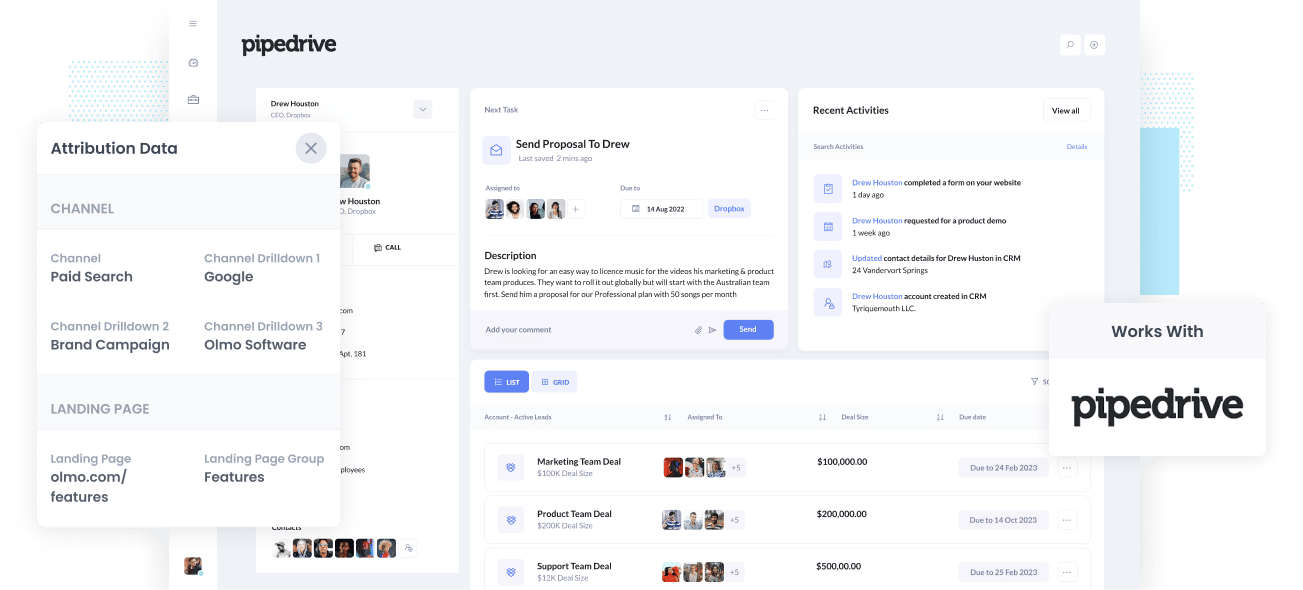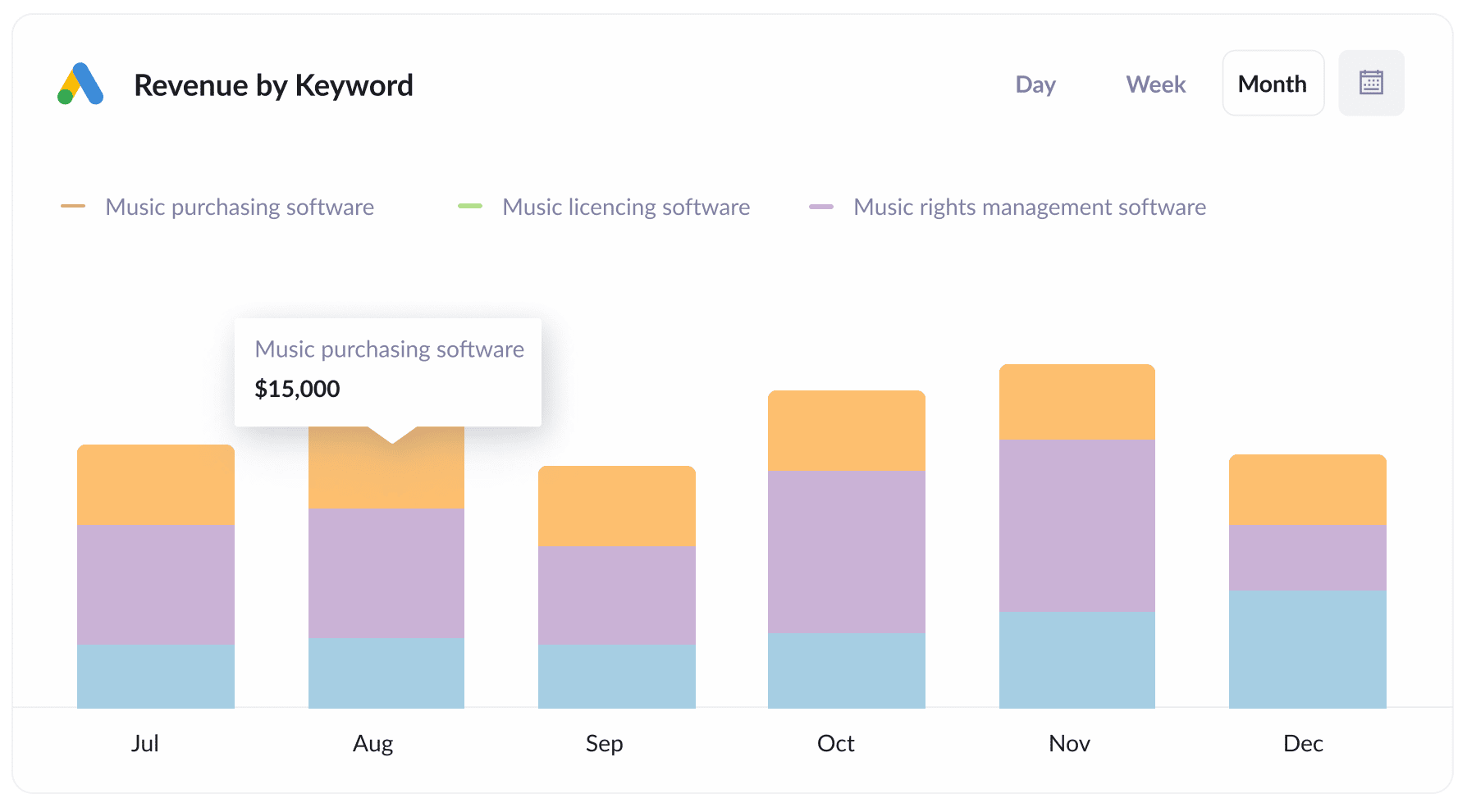The easiest way to get UTM Parameters into Pipedrive
Keep track of UTM parameters in Pipedrive and get to know what marketing campaigns are effectively bringing in leads and customers

It is important to identify which marketing channels and campaigns are the most effective in generating leads and sales.
Without the ability to do so, it is almost impossible to make smart decisions on which marketing strategies are the most impactful.
One way to identify the right channels and campaigns is to pass marketing attribution information (such as UTM parameters, landing page, and other marketing channel data) into your CRM. That way, you can create reports that identify what channels are driving leads, opportunities, customers, and revenue.
In this article, we'll show you how you can track marketing attribution information (such as UTM parameters) in Pipedrive
4 steps for capturing UTM parameters in Pipedrive
Using Attributer to capture UTM parameters in Pipedrive is easy. Here's how to do it in 4 easy steps:
1. Add UTM variables to your ads

Attributer won't be able to capture UTM parameters if they don't exist, so you need to make sure you add UTM codes to all of your ads and campaigns.
This includes ads on social platforms like Facebook, Twitter, Instagram & LinkedIn as well as search engines like Google & Bing. You should also add UTM codes on bespoke campaigns you conduct on other sites and publications (such as industry news sites, partner websites, etc).
2. Add hidden fields to your forms

The second step is to add hidden fields to your lead capture forms (I.e. your Contact Us form, Request A Demo form, whitepaper download forms, etc). The hidden fields you need to add to these forms are:
- Channel
- Channel Drilldown 1
- Channel Drilldown 2
- Channel Drilldown 3
- Landing Page
- Landing Page Group
Most form-building tools (like Contact Form 7, Gravity Forms, Wufoo, etc) make it easy to add hidden fields and instructions can be seen here.
3. Attributer automatically completes the hidden fields with UTM data

Now for the exciting part. When a site visitor submits a form, Attributer writes the UTM parameters into the hidden fields in your form and they are captured by your form tool alongside the information the lead entered into the form (such as their name, email, company, etc.)
4. UTM parameters are passed into Pipedrive

Finally, when a visitor submits the form on your website, all of the Channel data (derived from the UTM parameters) and the Landing Page data is passed into your CRM along with the name, email, phone, etc of the lead.
Once inside your CRM, you can then report on it using your existing reporting tools (I.e. Pipedrive reports, or your existing BI tool).
You should be able to see what channels are bringing the most leads, what the conversion rate to Opportunity is, how many Closed Won deals have come from each channel, etc.
What is Attributer?
From the steps above you can get an idea of how Attributer works to get UTM parameters into Pipedrive.
If you're interested in the more technical details around how it works though, Attributer is a nifty piece of code that, when placed on your website, looks at technical data such as UTM parameters, HTTP referrer information, device, etc. to ascertain where a particular visitor came from.
Based on that technical data, it then categorizes each visit into a series of channels - Paid Search, Organic Search, and Paid Social are good examples - and stores it in the visitor's browser as a cookie.
Then when that visitor completes a form on your website, Attributer writes those values to the hidden fields in your form and they are passed into your CRM.
Attributer was originally created by a marketing consultant who needed to better understand which marketing channels were generating the most leads and customers for his clients. After using it himself for a few years, he realized that it could be a valuable tool for others too.
Today, Attributer is installed on thousands of websites and provides attribution information for over 7 million visitors to those sites each month.
Why using Attributer is better than capturing raw UTM parameters
What makes Attributer different from the other tools on the market that capture UTM parameters?
Here are three good reasons to use Attributer:
1. Captures all traffic
Attributer is designed to capture all sources of traffic and pass them into Pipedrive. This means you'll get not only UTM parameters but also channel information on users who visit your site through organic channels where UTM parameters may be absent (like Direct, Referral, Organic Social, Organic Search, etc.)
Because Attributer captures all traffic sources, you'll be able to know where each and every lead comes from, including the ones that don't come from your paid ad campaigns.
2. Works across pages & visits
For most other UTM capture software on the market, the UTM parameters have to be present on the page where the visitor completes the form in order for the marketing data to be successfully passed through to Pipedrive.
But what if the page they complete the form on is different to the landing page of your ad?
Let's say a user clicks on your Google Ads and lands on the landing page that you set up for that ad campaign. If they click the ‘Contact Us' button and are redirected to another page to complete your contact form then this would mean that the UTM parameters are lost.
But Attributer does things a bit differently. We store the UTM parameters in a cookie in the user's browser, meaning the original UTM parameters are never lost even when the user completes a form on a different page to where they landed.
3. Provides cleaner data
Capturing raw UTM parameters is usually chaotic and you end up with a lot of messy data.
Here's an example. Imagine some of your LinkedIn campaigns are tagged with UTM_Source=LinkedIn.com (capital L and I), others with UTM_Source=linkedin (lowercase, no domain), and others with UTM_Source=li.
When you want to see how many leads your LinkedIn campaigns brought in and you try to run reports in Pipedrive, you'll be presented with three different sources of traffic that are really just the same. You'll need to manually stitch all these together just to know how many leads came from your LinkedIn campaigns.
Attributer helps you avoid this extra step because it already takes the possibility of inconsistencies (like capitalization and such) into account. It will attribute leads to Paid Social, and you get cleaner data.
4. Captures landing page data as well
You work so hard at creating quality content on your blog, so wouldn't it be great to know how it's performing?
With Attributer, you'll be able to. Attributer not only captures UTM parameters and other channel data but also captures info such as the landing page (I.e. dropbox.com/blog/collaborate-word-docs) & the landing page category (I.e. Blog). This lets you see if your hard work is paying off or if you may need to tweak your content to bring in more leads.
4 example reports you can run when you capture UTM parameters in Pipedrive
If you are using Attributer to capture UTM parameters and send them into Pipedrive alongside each lead, then you should be able to run reports similar to the following:
1. Leads by Channel

With Attributer, you can collect information on the source of ALL your leads, not just the ones from paid ad campaigns. This means you can create reports that (like the one above) which show the number of leads grouped by channel.
Such reports are helpful in identifying the channels that bring in the most leads and where you should focus your marketing investments. For instance, if Organic Search is generating most of your leads, but your budget is mostly going towards paid ads, it might be a good idea to shift some funds towards SEO.
2. Leads by Facebook Ads Network

The report above can be useful if you're running ads on the various networks that Facebook provides (such as Facebook, Instagram, Messenger, etc.) as it can help you figure out which network is bringing in the most leads.
In my experience, having this data can really help you optimize your ad spend. By adjusting your targeting settings to concentrate on the networks that are performing well, you can generate more leads at a lower cost per lead.
3. Customers by Google Ads campaign

The report shown above reveals the number of customers generated every month from your various Google Ads campaigns. It can assist you to see the campaigns that are genuinely producing customers (as opposed the campaigns that are just bringing visitors who don't convert).
A good example of this is search ads for different types of search terms (I.e. brand terms, competitor terms, product terms, etc). In my experience, leads from these different types of campaigns convert to customers at very different rates, and understanding that can help you focus your budget on the ones that are getting you the most customers.
4. Revenue by Keyword

If you put the keyword in the UTM parameters behind your Google Ads (which is easy to do using tracking templates), then you can capture the keyword your leads are using to find your business.
Not only can this help you to understand which keywords to bid higher on in Google Ads, but in the past I have used this information to help understand which terms to target in SEO, which words I should be using in my ad copy, and a whole lot more.
Wrap up
Attributer is more than just a UTM capturing tool.
Along with capturing and transferring UTM parameters to Pipedrive, it also gathers data on leads from channels where UTM parameters are absent. These channels include Organic Social, Organic Search, Referral, and others.
So with Attributer, you're able to see where ALL your leads & customers are coming from and make more informed decisions about how to grow your business.
Want to see how Attributer can benefit you? It's free to try, so start using it today.
Get Started For Free
Start your 14-day free trial of Attributer today!

About the Author
Aaron Beashel is the founder of Attributer and has over 15 years of experience in marketing & analytics. He is a recognized expert in the subject and has written articles for leading websites such as Hubspot, Zapier, Search Engine Journal, Buffer, Unbounce & more. Learn more about Aaron here.
